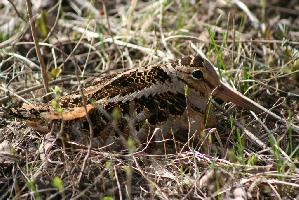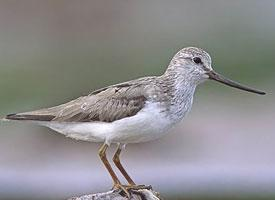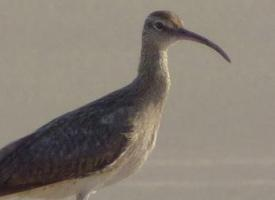
Description de l'animal
The American Woodcock (Scolopax minor), often referred to as the timberdoodle, is a small, intriguing bird that is a member of the sandpiper family, Scolopacidae. This species is particularly known for its unique behaviors, cryptic plumage, and the distinctive habitats it occupies within the forests and thickets of North America.Physical Characteristics:
The American Woodcock possesses a stocky body, measuring about 10 to 12 inches in length, with a short neck, large head, and a very long, straight bill which it uses to probe the soil for earthworms and other invertebrates. Its eyes are set far back on the head, giving it a nearly 360-degree field of vision, an adaptation that helps in spotting predators while its head is down, foraging. The woodcock's plumage is a masterclass in camouflage, featuring a mottled blend of browns, grays, and black, perfectly mirroring the forest floor's leaf litter.
Habitat and Distribution:
The American Woodcock is a migratory bird that breeds in young forests and thickets across eastern North America, from southern Canada down to the southern United States. It prefers habitats with moist soils, where it's easier to find its primary food source, earthworms. During the winter, it migrates to the southeastern United States, where it can be found in similar, but less dense, habitats.
Behavior and Diet:
Woodcocks are crepuscular, being most active during dawn and dusk. Their diet primarily consists of earthworms, which they hunt for with their sensitive bills, capable of detecting the worms' movements underground. This bird also consumes other invertebrates and occasionally plant matter.
One of the most fascinating aspects of the American Woodcock is its courtship display, known as the "sky dance." Performed by males in the early spring, this ritual begins with a series of nasal peent calls from the ground, followed by a sudden, spiraling flight up to 300 feet into the air. The bird then descends in a zigzagging manner, wings twittering, back to nearly the same spot it started from. This display, which is as much a treat to the ears as it is to the eyes, is done to attract females and to establish territory.
Conservation:
The American Woodcock is considered a game bird, and its populations are managed accordingly. Habitat loss due to the decline of young forests is a significant concern for woodcock conservation. Efforts to manage and create suitable habitats are crucial for the species' survival, as it relies on early successional forests, which are increasingly rare due to changes in land use and forestry practices.
In conclusion, the American Woodcock is a remarkable bird with an array of unique features and behaviors. Its existence underscores the importance of maintaining diverse habitats within our ecosystems. By understanding and appreciating the woodcock's life and needs, we can better ensure its place in North America's natural heritage for generations to come.
Animaux similaires
Nouvelles photos d'animaux
Top 10 des animaux
- Dolphin gull (Leucophaeus scoresbii)
- Diana monkey (Cercopithecus diana)
- Moustached guenon (Cercopithecus cephus)
- Galápagos tortoise (Geochelone nigra complex)
- Stone loach (Barbatula barbatula)
- Japanese macaque (Macaca fuscata)
- Russian tortoise (Testudo horsfieldii)
- Greek tortoise (Testudo graeca)
- Common flying dragon (Draco volans)
- Vendace (Coregonus albula)


